Related Research Articles
Pope Celestine II, born Guido di Castello, was head of the Catholic Church and ruler of the Papal States from 26 September 1143 to his death in 1144.
Pope Eugene III, born Bernardo Pignatelli, or possibly Paganelli, called Bernardo da Pisa, was head of the Catholic Church and ruler of the Papal States from 15 February 1145 to his death in 1153. He was the first Cistercian to become pope. In response to the fall of Edessa to the Muslims in 1144, Eugene proclaimed the Second Crusade. The crusade failed to recapture Edessa, which was the first of many failures by the Christians in the crusades to recapture lands won in the First Crusade. He was beatified in 1872 by Pope Pius IX.
Pope Lucius II, born Gherardo Caccianemici dal Orso, was head of the Catholic Church and ruler of the Papal States from 9 March 1144 to his death in 1145. His pontificate was notable for the unrest in Rome associated with the Commune of Rome and its attempts to wrest control of the city from the papacy. He supported Empress Matilda's claim to England in the Anarchy, and had a tense relationship with King Roger II of Sicily.
Boso was an Italian prelate and Cardinal of the Roman Catholic church.
Theodwin was a German cardinal and papal legate of the 12th century.
Jordan was a Carthusian monk, created Cardinal Deacon by Pope Lucius II in December 1144 and then Cardinal Priest of Santa Susanna by Eugene III on 21 December 1145. He is often referred to as a member of the Roman family of the Orsini, but more recent research concludes that he was probably a Frenchman. He served as Camerlengo of the Holy Roman Church under Eugene III and subscribed the papal bulls between 9 January 1145 and 11 June 1154.
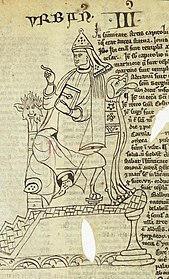
The 1185 papal election was a convoked after the death of Pope Lucius III. It resulted in the election of Cardinal Uberto Crivelli of Milan, who took the name of Urban III.
Imar, O.S.B. Cluny was a French Benedictine abbot, who served as a bishop and cardinal.

The 1159 papal election followed the death of Pope Adrian IV. It resulted in a double papal election. A majority of the cardinals elected Cardinal Rolando of Siena as Pope Alexander III, but a minority refused to recognize him and elected their own candidate Ottaviano de Monticelli, who took the name Victor IV, creating a schism that lasted until 1178.
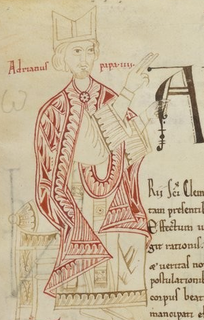
The 1154 papal election followed the death of Pope Anastasius IV and resulted in the election of Pope Adrian IV, the only Englishman to become pope.
Gerard de Namur was a cardinal born in Namur in the modern-day Belgium. In older historiography he is wrongly identified as Gerardo Caccianemici, nephew of Pope Lucius II.
The 1153 papal election followed the death of Pope Eugene III and resulted in the election of Pope Anastasius IV.
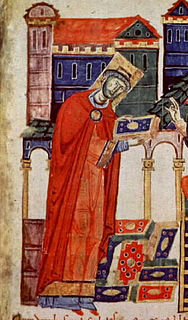
In the category of the members of the College of Cardinals in the central Middle Ages, an external cardinal was a Cardinal of the Holy Roman Church who did not reside in the Roman Curia, because of simultaneously being a bishop of the episcopal see other than suburbicarian, or abbot of an abbey situated outside Rome. In the wider sense, it may also concern cardinals who were appointed to the external episcopal sees and resigned their memberships in the College of Cardinals with this appointment. As well, it can concern cardinals who were generally curial cardinals, but for some time exercised the posts of administrators or prelates of the external churches.
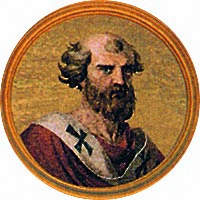
The 1143 papal election followed the death of Pope Innocent II and resulted in the election of Pope Celestine II.
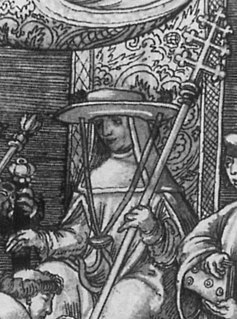
The 1144 papal election followed the death of Pope Celestine II and resulted in the election of Pope Lucius II.

The 1145 papal election followed the death of Pope Lucius II and resulted in the election of Pope Eugene III, the first pope of the Order of Cistercians.
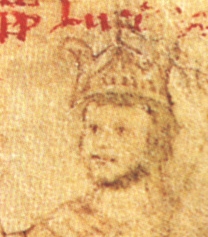
The 1181 papal election followed the death of Pope Alexander III and resulted in the election of Pope Lucius III. This was the first papal election celebrated in accordance with the decree Licet de evitanda discordia, promulgated in the Third Lateran Council in 1179, which established that the pope is elected by a majority of two thirds votes.
Pope Lucius II (1144–1145) created eleven cardinals in two consistories.
Pope Celestine II (1143–1144) created nine cardinals in one consistory:
References
- ↑ Brixius, p. 103 and W. Maleczek, Papst und Kardinalskolleg von 1191 bis 1216, Wien 1984, p. 248 note 283, say that his relationship with Pope Lucius II is not proven.